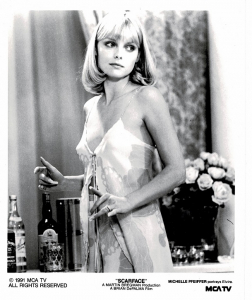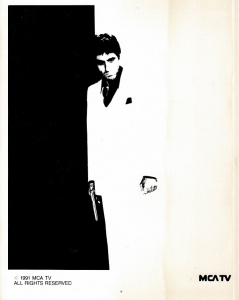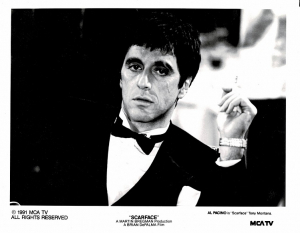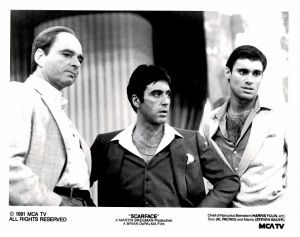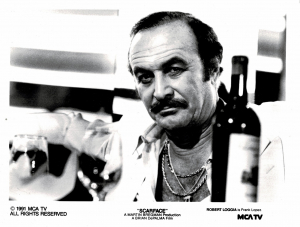BIOGRAPHY
AL PACINO
Desperate to make it to the top in America once he has safely joined the 1980 exodus from Castro’s Cuba, ex-con Tony Montana gets there the only way he knows how – by clawing his way up the junkpile of Miami’s thriving drug business.
It is a harrowing portrait of a new breed of ganster inan explosive new arena of power. To paint it, actor Al Pacino is on screen in virtually every scene.
To prepare for the role of Tony Montana, Pacino spent time in South Florida, soaking up the unique customs, ethics and accent of the “Marielitos” (so dubbed because they had sailed from the Cuban port of Mariel). Immersing himself in what he had just learned, he insisted on speaking “in character” both on and off the set during the several months the picture was in production. Such thoroughness is typical of Pacino.when I’m about to do a project,’ he admits, “I dream about the character all the time.”
Then he explains why:
“Acting is hard work,” he says. “At times, it’s both energizing and enervating. It’s childish, but it’s also responsibile. It’s illuminating … joyful … bizarre … diabolical … exciting. Acting may be, as Eleanor Duse said, a horrible world, but it’s an attempt to get at some truth, to show emotions and motivations which are both believable and natural.
“The most important thing to learn in acting is how not to act.”
Pacino takes that lesson seriously. Nominated for seven times for Academy Awards, his most memorable screen performances have been linked only by the same inner intensity that consumes Tony Montana in “Scarf ace.”
They are as Michael Corleone in “The Godfather, Part I, II, and III. The unpredictable street cop in “Serpico,” the sexually torturted bank robber in “Dog Day Afternoon,” and as the straightforward lawyer in “…And Justice For All.”
Pacino, in fact, nearly cornered the market on cinematic anti-heroes during the 1970s, starting with his first noteworthy role as a manipulative junkie in “The Panic in Needle Park.” A dramatic look at the highs and lows of drug addiction, it contained shockingly realistic scenes for filmgoers of 1971.
But then Pacino, a product/ of the New York stage, was already disturbing theatre audiences with his intense, brooding outsiders. Winner of an Obie Award for his performance as a drunken hood in the 1968 off-Broadway play, The Indian Wants The Bronx,” he also won coveted Tony, Drama Desk and Theatre World Awards for his Broadway debut as a psychotic drug addict in 19691s “Does A Tiger Wear A Necktie?”
It was those plays which brought him to the attention of Martin Bregman (then one of New York’s most respected personal managers), influencing both of their careers. Bregman subsequently produced both “Serpico” and “Dog Day Afternoon.”
Such antisocial roles are in direct contract to his tradition-bound upbringing in the Bronx. Born to Sicilian parents soon divorced, only-child Pacino was raised by his mother and grandparents with a careful, loving concern. (Forced to dress immaculately at all times, he was dubbed “the Little Dude” by neighborhood kids not known for their understanding). Lonely, bright and bored, Pacino acted out the films he saw for his grandmother … and in school continued to fabricate, making up a colorful past and mysterious life for himself to impress his classmates.
Encouraged by his family and teachers to become an actor, Pacino went to Manhattan’s High School of Performing Arts, then dropped out at seventeen to drift from job to job. He finally enrolled at the Herbert Berghoff Studio, where the serious commitment required of his craft was hammered home.
Pacino apprecnticed at such avant-garde off-off-Broadway theatres as Elaine Stewart’s Cafe La Mama and Julian Beck and Judith Malina’s Living Theatre, displaying a formidable bent for living each part he played.
It was his acceptance into the Actors Studio in 1966, however, with its advocacy of director Lee Strassberg’s ‘Method,’ that brought discipline and power to Pacino’s total absorption into his roles.
In 1972, after Pacino won not only the National Society of Film Critics Award for Best Actor, but an Academy Award nomination and international renown for his chilling role in “The Godfather,” he chose to return to the stage.
Joining David Wheeler’s Experimental Theatre Company of Boston, he starred in “The Basic Training of Pavlo Hummel” and later reprised the role on Broadway. It brought him a second Tony Award.”The theatre is where I started as an actor and it’s
what I enjoy doing,”comments Pacino. “I’m not loyal to it, but dedicated. It is what I should be doing. It’s crazy that the stage and screen are in competition with one another. It’s what I do as an actor, working both in films and on stage.”
Suiting action to words, Pacino has interspersed such films as “Scarecrow” and “Bobby Deerfield” with stage performances in “The Resistible Rise of Arturo Ui,” “Richard III,” “Camino Real,” “The Connection” and “Tiger at the Gates.”
STEVEN BAUER
If ever an actor seemed destined for a role, Cuban-born, Miami-reared Steven Bauer was born to play Manny Rivera in “Scarface.”
“Scareface” stars Al Pacino in the title role of Tony Montana, a Cuban ex-con who flees Castro’s jails during the “Marielito” boatlift of 1980.
Pursuing his “American dream” any way he can, Montana claws his way to the top of Miami’s thriving drug empire. Right beside him from Day One — funny, flashy, faithful as a Doberman and just as quick to go for the throat — is Manny. The role marks Bauer’s motion picture debut.
Although his surname belies it, he is the son of a Cuban Airlines pilot, who with his schoolteacher wife and three year-old son, fled Castro’s regime in 1959, leaving all possessions behind to avert suspicion.
It was to be another 21 years before the “Marielitos” came, but young Bauer saw firsthand the changes in Miami over the period, as more and more of his countrymen turned against Castro and opted for America.
“We were part of a large faction of Cuban society which moved to Miami,” he notes, recalling as well the culture shock of being immigrants. “Movies, especially musicals, were an important part of our lives during those years.”
By then billingual but shy, Bauer came home one day from seeing “Yankee Doodle Dandy” and sang all the film’s songs for his parents. They promptly encouraged him to study guitar and trumpet, and join both his high school choir and the Foreign Study League, whose student members spent their summers in Europe.
It was at Miami Dade Junior College, however, that Bauer became interested in acting. Cast in a small role in “Summer and Smoke,” he soon enrolled in any courses he could connect with theatre — drama, ballet, voice, modern dance.
His commitment deepened when he won a role as one of the Jets in the University of Miami production of “West Side Story.” Impressed with his potential, the school’s drama department helped cut the red tape to enroll him as a full- time student.
Studying with Actors Studios alumnus Robert Lowery brought Bauer his first formal training and his first leading role as Lenny in a “standing-ovation-every-night” production of “Of An Innocent Love.” Bauer also spent a year in New York studying with famed drama coach Stella Adler. While there he also returned briefly to the stage, appearing off-Broadway in “Waiting for Lefty” and “Mozart and Salieri.”
Still basically introverted except when acting, Bauer went for his direct opposite in depicting Manny in “Scarface.”
“Manny stands out in a crowd,” he explains. “He dresses to be noticed. He can be a hot-eyed ladies’ man and the next moment a cold-blooded killer.
“Because of his rebelliousness he was probably a reject within Cuba’s Socialist system, which demands strict conformity.”
He ran with the underground crime element, landed in jail, and learned the hard way that only the strong survive.
“So Manny is a survivor, doing whatever he has to do.
His only mistake is an inbred loyalty to his compadre Tony Montana.”
MICHELE PFEIFFER
The first time “Scarf ace” Tony Montana sees her — on the arm of Miami’s reigning drug king — he knows Elvira Hancock is the woman for him.
Blonde, fine-boned and confident in her nine-generatoin WASP heritage, she is the angel to top off his American dream.
After she becomes his wife, however, the dream — along with the angle — bites the dust. Deep within the ornate isolation of their Coral Gables mansion, she turns into a full-time junkie, unable to hide her boredom, her contempt… or her fading appeal.
Michele Pfeiffer is Elvira to Al Pacino’s Tony Montana in “Scarf ace,” Universal Pictures’ explosive drama about a ragged “Marielito” from Castro’s jails who claws his way to the top of Miami’s criminal hierarchy.
The Martin Bregman Production, directed by Brian De Palma (“Dressed to Kill”) from a screenplay by Oscar-winning Oliver Stone (“Midnight Express”), also stars Steven Bauer as Tony’s compadre, Mary Elizabeth Mastantonio as his kid sister, and Robert Loggia as Frank Lopez, the archrival from
whom Tony steals Elvira.
“She’s a lady who knows how to get what she wants,” explains actress Pfeiffer. “Elvira has survived in a violent world of street-smart, unsentimental people … and she has done it by never going beneath the surface of her feelings, never letting anyone get really close to her.
Her one saving grace is her awareness of her own short-fall. ‘Too bad we never grew up,’ she says to Tony in a farewell speech of surprising honesty.
“For Elvira, that says it all.”
Michele was born and raised in California’s conservative Orange County, where her businessman-father taught her one basic rule: If you wnt anything in life,
work for it … and that includes an acting career.
After graduating from Fountain Valley High School, where she first studied theatre, Pfeiffer clerked in a supermarket to pay for her acting lessons in Los Angeles, a long bus ride away.
Her first break came when a friend entered her in a Miss Los Angeles County beauty pageant. Chagrined at first, Pfeiffer changed her mind when the incident brought her an agent. Her first role followed –‘so small that “my character didn’t even have a name; I was called ‘The Bombshell,” — in the television series, “Delta House.”
Then a month later she was cast in her first motion picture, “Falling in Love Again.” Not wanting to lose either opportunity, she worked seven days a week, almost around the clock, for two months.
While her hard-working father would have approved, for 18-year old Pfeiffer it meant performing on the series during the day, and on the movie nights and weekends.
It paid off. Roles followed in both television and feature films.
In “Hollywood Knights” she co-starred as “Susy-Q,” the carhop. “I understood her completely,” Pfeiffer recalls.
“Like me, she was a young girl who left her solid home to come to Hollywood to be an actress. But she’s working as a carhop instead.”
Then came her first chance to portray a debutante — the rich, sheltered Cordelia Farrington III – in “Charlie Chan and the Curse of the Dragon Queen,” a spoof which starred Peter Ustinov, Lee Grant and Roddy McDowell.
Alternating with television movies, Pfeiffer appeared in “Callie and Son,” then co-starred in “The Children That Nobody Wanted and “Splendor in the Grass.” Not one to sit around, she then tried her hand at live theatre, appearing in a Los Angeles Equity waiver production of “Playground in-the Fall,” before entering the nationwide talent search for “Grease 2.”
Winning that role encouraged Pfeiffer to pursue her next goal — playing Al Pacino’s leading lady in “Scarface.”
Convinced she understood Elvira and could “do justice to the characterization,” she underwent three months of readings on both coasts and finally, after a screen test, won the coveted role.
Although it’s “something an actress dreams of,” the pretty, persistent young beauty from Orange County admits, “it took a lot for me to go beyond the fact that my leading man was Al Pacino.”
MARY ELIZABETH MASTRANTONIO
“Gina Montana is a little spicier than anything I generally get to play,” says screen newcomer Mary Elizabeth Mastrantonio of her role in Universal Pictures’ “Scarface.”
A Martin Bregman Production, directed by Brian De Palma from a screenplay by Oscar-winner Oliver Stone, the film stars Al Pacino as “Scarface” Tony Montana, a Cuban ex-con fresh from Castro’s jails, who claws his way up the criminal hierarchy of Miami to grab his share of the “American Dream.”
His co-stars are Steven Bauer as his compadre, Michelle Pfeiffer as his beautiful wife, Robert Loggia as his archrival, and Mastrantonio as his kid sister, Gina.
In true macho fashion, Montana views his sister as someone to be protected, put on a pedestal and big-brothered within an inch of her life.
Gina has other ideas.
“She adores Tony,” explains actress Mastrantonio.
“He’s the one who has always brought enjoyment into her life.
But because of him, their family goes from being dirt poor to very rich, with all the power — and freedom — that money can buy.
“When she sees Tony doing dope, she wants to try it, too. ‘After all,’ she says to herself, ‘if it’s good enough for him, it’s good enough for me.’”
It isn’t, of course. In Tony’s mind it’s a threat to the innocence — as is her ripening romance with his best (and only) friend, Manny. Tony deals with the first so abruptly and the second so brutally that Gina’s hero-worship crumbles in one of the film’s most shocking scenes.
Playing a young woman who is both passive and passionate is an admitted challenge for Mastrantonio.
Seen on Broadway in the hit “Amadeus”, the young Chicago suburbanite has an impressive list of credits in the musical theater — as the ingenue in most of them.
(She finds playing Gina — “the one with the makeup and the razzle-dazzle and the spice” — a welcome change.)
The fifth of six sisters, Mastrantonio began her musical theater training at Oak Park-River Forest High School, where its “three theaters and 4,500 students had as many as nine productions going at one time.”
Enrolling next at the University of Illinois, she polished her skills further by majoring in music and voice and appearing in student musical productions.
After making her professional bow during summers with Nashville’s Opryland productions of “Showboat” and “For Me and My Gal”, Mastrantonio joined the Lincolnshire Marriott Theater for a season of five Equity musicals, including “Camelot”, “The Sound of Music,” “Cabaret” and “Rodgers and Hart, A Musical Celebration.”
She made her Broadway debut as the understudy for Maria in the revival of “West Side Story”, Mastrantonio remained to appear in “Copperfield” (as Dora) and in “Oh, Brother.”
It was in 1982 that Mastrantonio was cast in her first non-musical theatrical role – in Broadway’s “Amadeus”, which starred Frank Langella. With the show for six months, she first played Katerina, then the co-starring role of Costanza.
“It was the perfect opportunity for me to break into a non-musical,” she recalls. “At first, I was the understudy and got a workout. That way you learn a lot because you don’t have the pressure of having to create that role and to be critiqued for it.”
Such was not the case, however, with “Scarface,” for which she was cast one week after the reading.
Not only was she the first actress to play Gina (Hancock) Montana, she was also performing in front of a camera for the first time.
How did she feel?” Liberated,” she says. “It’s strange. There’s this feeling that nothing can touch you.
People are hanging lights and holding microphones right over your head, which is very unnatural, yet there is something comforting in it.
“The camera seems to put up a fourth wall between you and the rest of the world.”
ROBERT LOGGIA
When Cuban refugee “Scarface” Tony Montana gets sprung from a detention/holding camp, it’s because he has just iced an inmate for wealthy Miamian Frank Lopez.
A man with a sharp eye for talent, Lopez puts “Scarface” to work in his flourishing drug empire. But when the young hood’s ambitions extend to Lopez’ territory – and then to his beautiful wife – a blood feud begins.
Robert Loggia plays Frank Lopez to Al Pacino’s Tony Montana in “Scarface,” Universal Pictures’ explosive drama of the rise and fall of a modern-day gangster.
Directed by Brian De Palma from a screenplay by Oscar- winner Oliver Stone, the Martin Bregman Production also stars Steven Bauer as Tony’s compadre, Michelle Pfeiffer as his well-bred wife and Mary Elizabeth Mastrantonio as his hero-worshiping kid sister.
For veteran actor Loggia, portraying a narcotics kingpin takes him nearly full circle. He made his professional bow 28 years ago as Frankie Machine in off-Broadway’s “The Man With the Golden Arm”, the trailblazing play about drug addition.
In 1983 Loggia portrayed psychiatrist Dr. Raymond in Universal’s “Psycho II” and the late Egyptian President Anwar Sadat in the honored television special, “A Woman Called Golda.” He also played Bruno Langois in “The Curse of the Pink Panther.”
A native New Yorker, he earned a degree in journalism from the University of Missouri and served in the Army during the Korean War before turning to acting.
Studying first with Stella Adler, Loggia joined the Actors Studio in 1955 for their production of “Three Sisters”, and has been a member ever since.
Other stage credits include starring roles in Lillian Helman’s Toys in the Attic, opposite Ruby Dee in “Wedding Band”, and opposite Madeline Kahn in “In the Boom Boom Room”.
He has also appeared in and produced off-Broadway’s Passing Through From Exotic Places.
After making his film debut with “Somebody Up There Likes Me,” Loggia went on to appear in “The Greatest Story Ever Told,” “Che,” “First Love,” “The Revenge of the Pink Panther,” “S.O.B.” and “An Officer and a Gentleman.” “Prizzip, Honor,” and “Big”, most recently Neil Simon’s “The Marrying Man”.
His television credits include guest-starring roles on all networks, two series of his own (“T.H.E. Cat” and “The Nine Lives of Elfego Baca”), such ‘Golden Age’ live dramas as “Studio One,” “Robert Montgomery Presents” and “Play of the Week,” in which he gave noteworthy performances in “Miss Julie” and “Legends of Lovers.” Currently he stars as Nick Mancuso in the Weekly TV series “Mancuso FBI.”
His appearances include the production of “The Chicago Conspiracy Trial,” in which he played attorney Leonard Weonglass, and “The Trial of Inez Garcia,” in which he portrayed another well-known lawyer, San Francisco’s Charles Garry.
In 1980, Loggia joined the ranks of the Directors Guild by guiding Jack Klugman through an episode of “Quincy,” for which he received an NAACP nomination as Director of the Year.
